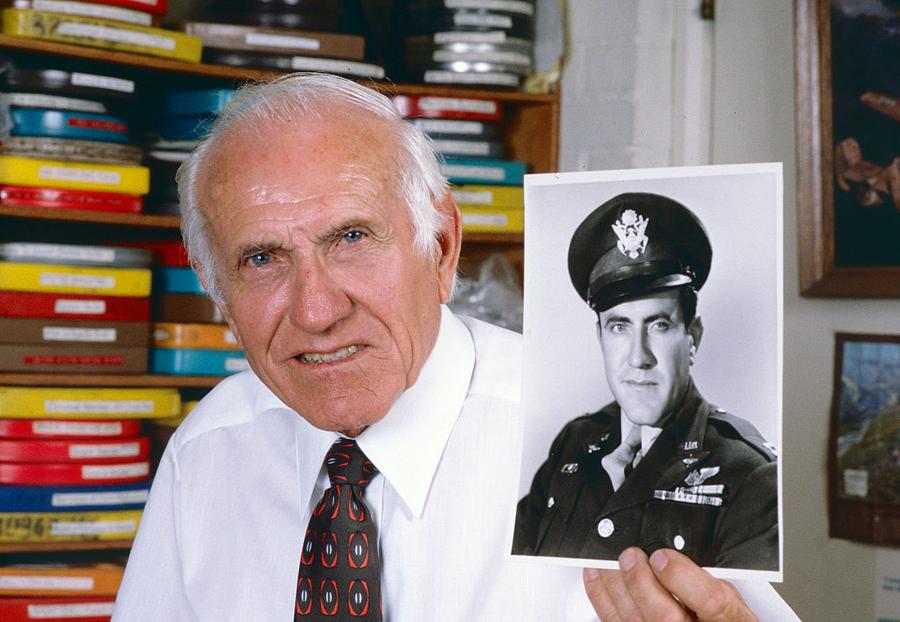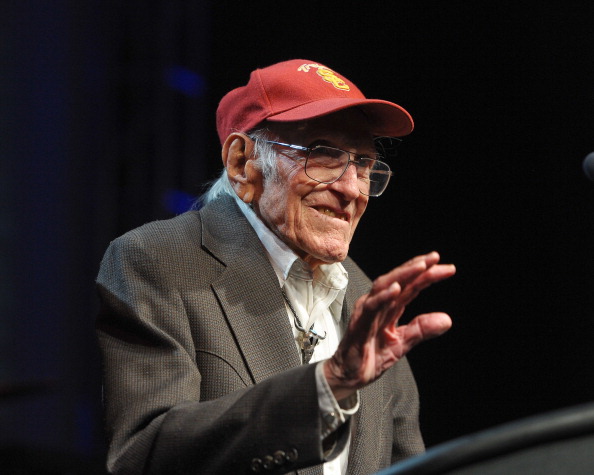What Was Louis Zamperini's Net Worth?
Louis Zamperini was an American prisoner of war survivor, Olympic distance runner, and inspirational speaker who had a net worth of $3 million at the time of his death in 2014. Louis Zamperini's experiences inspired the best-selling 2010 book "Unbroken: A World War II Story of Survival, Resilience, and Redemption," which was written by Laura Hillenbrand. The book was adapted into the 2014 movie "Unbroken," which grossed $163.4 million at the box office and was named one of the year's best films by the American Film Institute and National Board of Review. Louis competed in the 1936 Olympics 5000-meter race and finished 8th.
Zamperini joined the United States Army Air Forces in 1941 and became a second lieutenant. He was deployed to the Pacific Island of Funafuti on the B-24 Liberator bomber Super Man. While on a search, his plane crashed into the ocean and killed eight of the eleven men on board. Louis and two other survivors reached the Marshall Islands and were captured by the Japanese Navy and held as prisoners of war. A year and a half after he disappeared, he returned home and eventually became a Christian evangelist with the help of Billy Graham. Zamperini published three books: "Devil at My Heels: The story of Louis Zamperini" (1956), "Devil at My Heels: A World War II hero's epic saga of torment, survival, and forgiveness" (2003), and "Don't Give Up, Don't Give In: Lessons from an extraordinary life" (2014). He received many awards, including a Purple Heart, Prisoner of War Medal, and World War II Victory Medal. Louis Zamperini passed away on July 2, 2014, at the age of 97.
Early Life
Louis Zamperini was born Louis Silvie Zamperini on January 26, 1917, in Olean, New York. He was the son of Louise Dossi and Anthony Zamperini, who both came from Italy. Louis grew up with three siblings, Pete, Sylvia, and Virginia, in a strict Catholic household, and he started drinking and smoking at a young age, When Zamperini was two years old, his family moved to Long Beach, California, then they relocated to nearby Torrance. Louis and his family didn't speak English when they moved to the West Coast, and Zamperini was bullied because of his Italian heritage. Anthony taught Louis to box so he would be able to defend himself, and according to Zamperini, he was soon "beating the tar out of every one of them." While attending Torrance High School, Louis was a member of the track team alongside his brother, Pete. As a freshman, Zamperini came in fifth in the All City C-division 660 yards (600 m) dash. He spent the summer of 1932 running, and he was undefeated during his last three years of high school. In 1934, Louis ran a mile in 4 minutes, 21.2 seconds, setting an interscholastic record, and he finished in first place at the CIF California State Meet championships the following week. He accepted a scholarship to attend the University of Southern California, where he joined the Kappa Sigma fraternity's Delta Eta chapter and set a national collegiate record after running a mile in 4 minutes, 8.3 seconds.
In 1936, Zamperini tried out for the Olympics and qualified in the 5000 m, making him the youngest American to qualify for that event, at the age of 19 years, 178 days. At the Olympic Games in Berlin, he finished in eighth place in the 5000 m, with a time of 14 minutes, 46.8 seconds. Louis finished the final lap in 56 seconds, which caught the attention of Adolf Hitler. According to Zamperini, Hitler shook his hand and called him "the boy with the fast finish."

(Photo by Bob Riha, Jr./Getty Images)
Military Career
Louis graduated from college in 1940, then he enlisted in the U.S. Army Air Forces in September 1941 as an aviation cadet, earning commission as a second lieutenant. He served as a bombardier on Super Man, a Consolidated B-24 Liberator bomber, on the Pacific island of Funafuti. In April 1943, Super Man took part in a bombing mission against the island of Nauru, which was held by the Japanese, with Zamperini as bombardier. The raid was successful, but three Japanese Zeros attacked Super Man, severely damaging the bomber. Five crew members were wounded, and one of them died. "New York Times" credited Louis with giving first aid to the wounded members of his crew. Zamperini was then sent to Hawaii to search for a lost aircraft. The crew was given a B-24 called Green Hornet, which was said to be defective, and it crashed into the ocean on May 27, 1943. Eight of the 11 men onboard died in the crash. The three survivors, Zamperini, Francis McNamara, and Russell Allen Phillips, were at sea for weeks, and after 33 days, McNamara died. Zamperini and Phillips made it to the Marshall Islands on their 47th day at sea and were captured by the Japanese Navy.
While being held captive, the men were mistreated and severely beaten until the war ended in August 1945. They were originally held at Kwajalein Atoll, but after 42 days, they were transferred to Ōfuna's Japanese prisoner-of-war camp, which was for captives who had not been registered as POWs. Just over a year later, Louis was sent to the Ōmori POW camp in Tokyo, followed by the Naoetsu POW camp in northern Japan. During his time at Omori and Naoetsu, Zamperini was tormented by Mutsuhiro "The Bird" Watanabe, who was later named one of Japan's 40 most wanted war criminals by General Douglas MacArthur.

Getty Images
Personal Life and Death
In 1946, Louis married Cynthia Applewhite. The couple remained together until Cynthia's death in 2001, and they welcomed daughter Cissy in 1949 and son Luke in 1953. After returning home from the war, Zamperini developed post-traumatic stress disorder, and during a night terror, he unintentionally strangled Applewhite while she was pregnant. He also began struggling with alcohol addiction, which prompted Cynthia to ask for a divorce. However, she changed her mind after she attended one of Billy Graham's evangelistic crusades and became a born-again Christian.
While serving during World War II, Louis' death was mistakenly announced, with the U.S. government saying he had been killed in action when he was actually a prisoner of war. President Franklin D. Roosevelt sent Zamperini's parents a condolence letter in 1944, but in late 1945, it was discovered that Louis was alive. Seventy years later, Zamperini passed away from pneumonia on July 2, 2014, at the age of 97.
Honors
Zamperini received several Presidential Unit Citations, including the Bombardier Badge, Distinguished Flying Cross, Purple Heart, Prisoner of War Medal, American Defense Service Medal, Asiatic-Pacific Campaign Medal, World War II Victory Medal, Air Medal, and Philippine Liberation Medal. In 1946, the Torrance Airport was renamed Zamperini Field in his honor, and his alma mater, Torrance High School, named Zamperini Stadium and Louis Zamperini Plaza after him in 2004. Louis served as a torchbearer in the 1984 Summer Olympic Games and 1998 Winter Games. In 2008, he received the National Ethnic Coalition of Organizations' Ellis Island Medal of Honor and was inducted into the National Italian American Sports Hall. Zamperini received an honorary Doctor of Humane Letters from both Azusa Pacific University and Bryant University, and he was presented with Bryant University's Distinguished Character Award after giving the baccalaureate address in 2011. In 2014, Louis' hometown, Olean, New York, dedicated a monument to him at War Veterans Park. In 2017, part of the 405 Freeway between Western Avenue and Redondo Beach Boulevard was named the Louis Zamperini Memorial Highway.
Real Estate
Zamperini lived in a 3,500-square-foot Hollywood Hills home, which included four bedrooms and three bathrooms. His family trust sold the home to an LLC for $2.19 million in 2015.










 Bengali (BD) ·
Bengali (BD) ·  English (US) ·
English (US) ·